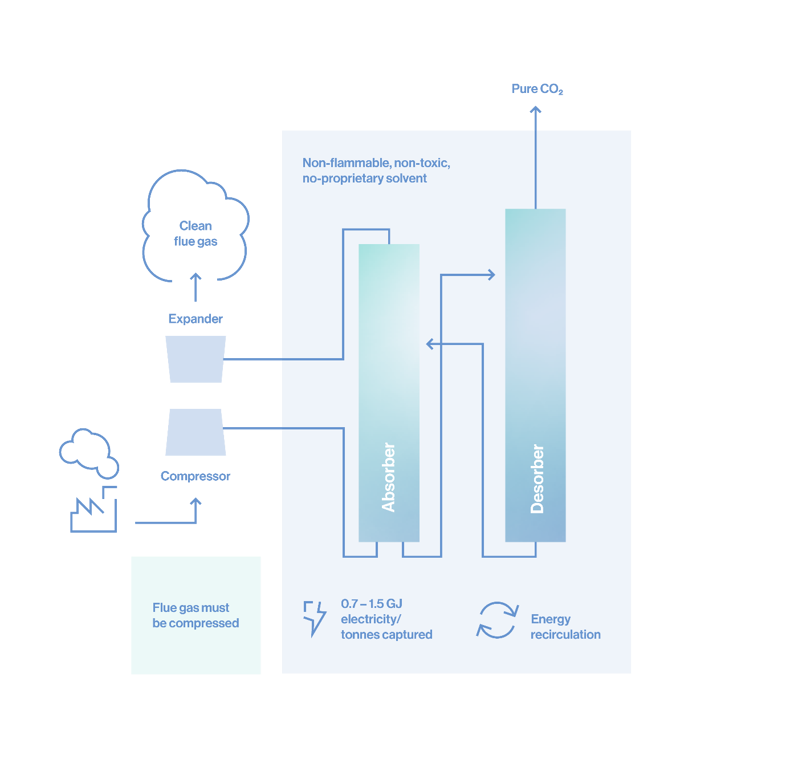Efficient carbon capture technology with eco-friendly and safe sorbent
Sumitomo SHI FW (SFW) offers you a reliable and efficient carbon capture solution, Hot Potassium Carbonate (HPC+) technology, that integrates seamlessly into existing plants. SFW works together with several technology partners and is always open to find new ways and collaborations to drive forward the best ways to capture carbon emissions. To perfect the HPC+ technology, SFW currently works together with partner Capsol Technologies to incorporate their patented CapsolEoP(R) heat recovery technology into SFW's HPC+ system.
By capturing up to 90% of CO2 emissions with a low-cost, safe, and environmentally friendly solvent, HPC+ helps industries reduce their carbon footprint while supporting energy efficiency and acting as a power-to-heat plant. For customers, this means fewer headaches, faster deployment, and a scalable solution that fits their needs.
Tabs
Hot Potassium Carbonate technology is designed to efficiently capture CO2 from industrial emissions while maximizing energy recovery. Here’s how the process works:

Stage 1: Flue Gas Cooling, Cleaning, and Compression
Initially, the flue gas is cooled, and impurities are removed to prepare it for the carbon capture process. Next, the flue gas is compressed to high pressure, reducing its volume and driving the carbon capture reaction. After compression, the flue gas is fed into the absorber.
Stage 2: CO2 Absorption
In the absorber, potassium carbonate (K₂CO₃) reacts with CO2 and water from the compressed flue gas, forming potassium bicarbonate (KHCO₃). This step captures the CO2 from the gas stream efficiently, preparing it for the regeneration process.
Stage 3: Regeneration and CO₂ Release
The solution rich in potassium bicarbonate is transferred to a desorber or stripper, where it is heated. The heat, supplied either by waste or low-quality heat from the existing industrial or power plant or via recirculated steam compressors, powers the process. Some heat is also recovered from the initial gas compression step. This stage regenerates potassium carbonate (K₂CO₃), releasing high-purity CO₂ for storage or further industrial use.
Stage 4: Recycling and Energy Recovery
Finally, the regenerated potassium carbonate is recycled back to the absorber, completing the cycle. At the same time, energy is recovered from the process, including compression and desorption steps. This energy can be repurposed for district heating or industrial applications, enhancing overall efficiency and reducing operational costs.
Energy Recovery and Power-to-Heat Conversion
HPC+ technology not only captures CO₂ but also recovers heat from the process, converting it into valuable energy. This heat can be used for industrial applications or repurposed as district heating, significantly enhancing energy efficiency and boosting the capacity of district heating networks.
Flexible Energy Sources
The system can operate on electricity or steam, allowing operators to choose the most cost-effective energy sources based on availability and operational needs.
Eco-friendly and Safe Solvent
The Hot Potassium Carbonate (HPC+) process is designed with health, safety, and environmental sustainability in mind. Its use of a non-toxic, non-volatile, and oxygen-resistant solvent ensures safe handling for operators and minimizes environmental impact.
Low Operational Costs
Potassium carbonate is affordable, and the system’s low solvent management costs make HPC+ an economically viable carbon capture solution for industries.
Flexible and Scalable Design
The technology is adaptable to both new and existing facilities across various industrial sectors. It enables seamless integration into existing operations, minimizing site disturbance during installation.
Proven Technology
With hundreds of references and decades of operational experience, HPC+ is a reliable carbon capture solution with a proven track record.
High Carbon Capture Efficiency
HPC+ achieves industry standard CO2 capture rates, ensuring reliable and efficient operation with superior performance for a sustainable future.
Cost-effective Solution
Potassium carbonate is a widely available, cost-efficient solvent. Additionally, energy recovery features help repurpose heat for industrial use, while flexible power options enhance adaptability.
Rapid Deployment
The carbon capture plant integrates seamlessly into existing facilities or new projects. Its flexible design ensures quick and cost-effective delivery, simplifying the path to emissions compliance.


